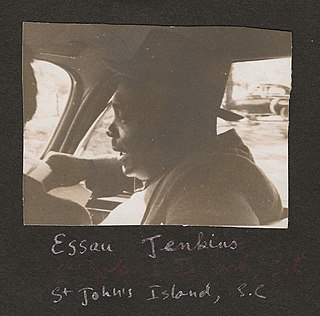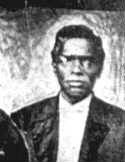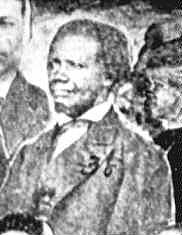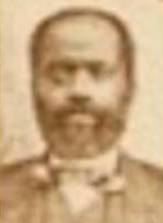
Fort Mose, originally known as Gracia Real de Santa Teresa de Mose, and later as Fort Mose, or alternatively, Fort Moosa or Fort Mossa, is a former Spanish fort in St. Augustine, Florida. In 1738, the governor of Spanish Florida, Manuel de Montiano, had the fort established as a free black settlement, the first to be legally sanctioned in what would become the territory of the United States. It was designated a US National Historic Landmark on October 12, 1994.

Esau Jenkins was a South Carolina African-American Human Rights leader, businessman, local preacher, and community organizer. He was the founder and leader of many organizations and institutions which helped improved the political, educational, housing, health and economic conditions of Sea Island residents.
William Edward Elcha was an American photographer known for his Jazz Age Broadway photographs of Harlem performers and celebrities in the 1920s and 1930s. The Harry Ransom Center has his photographs in its collection. He also partnered with Percy Tappin, and The National Museum of African American History and Culture has a photo postcard from their studio of the Jenkins Orphanage Band from Charleston, South Carolina.
James P. Newton was a photographer in Memphis, Tennessee. He is noted as the city's first African American professional photographer and as an influential documenter of the city's history. Several of his cabinet card photographs remain including in the University of Memphis' collection.
Francis M. Kneeland was an American physician. She was one of the first African American women doctors working in Memphis, where she had a practice located on Beale Street.
William "Beverly" Nash was a barber, shoe shine, porter, waiter, and state senator in South Carolina. An African American, Nash was born enslaved in Virginia, Nash gained his freedom at the age of 43 with the passage of the 13th Amendment. After the Civil War he became a state legislator during the Reconstruction Era. He was instrumental in drafting South Carolina's Constitution of 1868, and held several committee positions in the state government over his career. He held his office for 21 years before resigning.
Simeon Farr was an American politician who was elected as a state representative in 1868 in South Carolina during the Reconstruction era. He represented Union County, South Carolina. His photograph was used in a composite of Radical Republican officials from South Carolina. His name is spelled Simon Farr in an 1868 House document.

Samuel Nuckles was a legislator in South Carolina during the Reconstruction era. He represented Union County. A Republican, he gave testimony about a campaign of intimidation used by Democrats and the Ku Klux Klan in the 1870 election. In 1871 he was part of a delegation sent to Washington D.C. requesting federal troops to address "outrages". He testified that he was a former slave and could read a little and write his name. He also testified that he was a refugee from Union County due to threats of violence and Ku Klux Klan attacks.

Junius S. Mobley, also known as June Mobley, was a politician in South Carolina. He was considered an ultra-radical, and was one of South Carolina's 1868 Radical Republican members of the Legislature. He reportedly became a preacher after the Reconstruction era. Mobley was a political leader during the Reconstruction era in South Carolina and was involved in the distribution of ammunition to freedmen. He was part of the Union Brotherhood that replaced the Union League in 1872. Mobley was from Union County, South Carolina. John Schreiner Reynolds wrote about Mobley and other African American legislators in 1905. He was not a fan of Mobley's, and described him as "mulatto" and said he gave incendiary speeches causing bloodshed for the "men of his own race". He also referred to Mobley as a "vicious and mouthy Negro".

Powell Smythe was a member of the South Carolina General Assembly during the Reconstruction era. He represented Clarendon County, South Carolina.

Edward Charles Mickey was a Reconstruction era legislator in South Carolina. His occupation was listed as tailor and minister. He served in the South Carolina House of Representatives from 1868 until 1872. He was one of many African American legislators who served as Republicans in South Carolina's House and Senate in 1868. He represented Charleston County. He was born in Charleston, South Carolina.

Sancho Saunders was a member of South Carolina's House of Representatives during the Reconstruction era. He represented Chester County, South Carolina. He was documented as a literate Baptist minister who was a slave before the American Civil War. He was African American. His photograph was included in a montage of Radical Republican South Carolina legislators.
William J. Brodie was a legislator in South Carolina during the Reconstruction era. He was identified as a mullato bricklayer who was literate. Another document lists him as a carpenter. He served in the South Carolina House of Representatives from 1876 until 1880.

Ebenezer (Eben) Hayes was a farmer, Methodist preacher and a member of the South Carolina House of Representatives, during the Reconstruction era.

John Hannibal White was a delegate to South Carolina's 1868 Constitutional Convention, a two-term member of the South Carolina House of Representatives, and a state senator in South Carolina. He worked as a blacksmith.
Henry L. Shrewsbury was an American teacher and Reconstruction era state legislator in South Carolina. He was described as a free mullato, and represented Chesterfield County in the South Carolina House of Representatives from 1868 until 1870.
Franklin F. Miller was a politician in South Carolina. He represented Georgetown, South Carolina, at the Constitutional Convention of 1868 and served in the state legislature. His photograph was included in a montage with other Radical Republican legislators. He was identified as "colored" and had not been recorded on tax roles. A document related to the 1868 Convention identifies him as white.
Edward Petty was a state legislator in South Carolina. He served in the South Carolina House of Representatives from 1872 to 1874. He lived in Charleston County, South Carolina.
Isaac Alston was a reverend and state legislator in North Carolina. He represented Warren County, North Carolina in the North Carolina Senate in 1870 and 1891. He lived in Warrenton, North Carolina. He was the only African American elected to the North Carolina Senate in 1890. Three African Americans were elected to the North Carolina House of Representatives that year.
Burrell S. James was a state legislator in South Carolina. He served in the South Carolina House of Representatives. His photograph was included in a montage of "Radical Republican" South Carolina state legislators.









